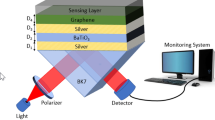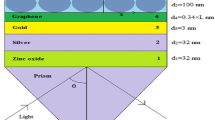Abstract
In the present work, a highly sensitive SPR biosensor based on silver (Ag), barium titanate (BaTiO3), graphene, and affinity layer is proposed for the detection of Pseudomonas bacteria. The performance of this proposed sensor has been numerically studied and analyzed for sensitivity, quality parameter, and detection accuracy. The proposed structure used attenuated total reflection (ATR) approach based on the Kretschmann configuration for the investigation of performance parameters. The inclusion of the BaTiO3 layer along with the affinity layer shows the enhancement in the performance of the proposed structure for the detection of Pseudomonas bacteria. A comparison of the proposed structure is drawn with contemporary surface plasmon resonance (SPR) biosensors for the detection of Pseudomonas bacteria, and better performance was shown. This work reports that the maximum sensitivity, quality parameter, and detection accuracy for the proposed sensor are 220 degree/RIU, 101.38 RIU−1, and 7.09 respectively. Therefore, the proposed design finds its application in Pseudomonas bacterial detection as well as opens a new window in the biosensing area.






Similar content being viewed by others
References
Riveros-Rosas H, Julian-Sanchez A, Moreno-Hagelsieb G, Munoz-Clares RA (2019) Aldehyde dehydrogenase diversity in bacteria of the Pseudomonas genus. Chem Biol Interact 304:83–87. https://doi.org/10.1016/j.cbi.2019.03.006
Hossain Z (2014) Bacteria: Pseudomonas. Encycl Food Saf 1:490–500. https://doi.org/10.1016/B978-0-12-378612-8.00109-8
Liu T, Hou J, Peng Y (2017) Effect of a newly isolated native bacteria, Pseudomonas sp. NP22 on desulfurization of the low-rank lignite. Int J Miner Process 162:6–11. https://doi.org/10.1016/j.minpro.2017.02.014
Kushwaha AS, Kumar A, Kumar R, Srivastava M, Srivastava SK (2018) Zinc oxide, gold and graphene-based surface plasmon resonance (SPR) biosensor for detection of pseudomonas like bacteria: a comparative study. Optik 172:697–707. https://doi.org/10.1016/j.ijleo.2018.07.066
Verma A, Prakash A, Tripathi R (2016) Sensitivity improvement of graphene based surface plasmon resonance biosensors with chaclogenide prism. Optik 127:1787–1791. https://doi.org/10.1016/j.ijleo.2015.11.083
Verma A, Prakash A, Tripathi R (2015) Performance analysis of graphene based surface plasmon resonance biosensors for detection of Pseudomonas-like bacteria. Opt Quant Electron 47:1197–1205. https://doi.org/10.1007/s11082-014-9976-1
Mishra SK, Gupta BD (2012) Surface plasmon resonance-based fiber-optic hydrogen gas sensor utilizing indium–tin oxide (ITO) thin films. Plasmonics 7:627–632. https://doi.org/10.1007/s11468-012-9351-7
Shushama KN, Rana MM, Inum R, Hossain MB (2017) Graphene coated fiber optic surface plasmon resonance biosensor for the DNA hybridization detection: simulation analysis. Opt Commun 383:186–190. https://doi.org/10.1016/j.optcom.2016.09.015
Kabiraz DC, Morita K, Sakamoto K, Takahashi M, Kawaguchi T (2018) Highly sensitive detection of clenbuterol in urine sample by using surface plasmon resonance immunosensor. Talanta 186:521–526. https://doi.org/10.1016/j.talanta.2018.04.011
Zhou J, Qi Q, Wang C, Qian Y, Liu G, Wang Y, Fu L (2019) Surface plasmon resonance (SPR) biosensors for food allergen detection in food matrices. Biosens Bioelectron 142:111449. https://doi.org/10.1016/j.bios.2019.111449
Rahman MS, Hasan MR, Rikta KA, Anower MS (2018) A novel graphene coated surface plasmon resonance biosensor with tungsten disulfide (WS2) for sensing DNA hybridization. Opt Mater 75:567–573. https://doi.org/10.1016/j.optmat.2017.11.013
Sharma AK, Pandey AK (2018) Blue phosphorene/MoS2 heterostructure based SPR sensor with enhanced sensitivity. IEEE Photon Technol Lett 30(7):595–598. https://doi.org/10.1109/LPT.2018.2803747
Bijalwan A, Singh BK, Rastogi V (2020) Surface plasmon resonance-based sensors using nano-ribbons of Graphene and WSe2. Plasmonics:1–9. https://doi.org/10.1007/s11468-020-01122-w
Fletchert M, Loeb GI (1979) Influence of substratum characteristics on the attachment of a marine pseudomonad to solid surfaces. Appl Environ Microbiol 37(1):67–72
Choi SH, Kim YL, Byun KM (2011) Graphene-on-silver substrates for sensitive surface plasmon resonance imaging biosensors. Opt Express 19(12):458–466. https://doi.org/10.1364/OE.19.000458
Roy K, Padmanabhan M, Goswami S, Sai TP, Ramalingam G, Raghavan S, Ghosh A (2013) Graphene-MoS2 hybrid structures for multifunctional photoresponsive memory devices. Nat Nanotechnol 8(11):826–830. https://doi.org/10.1038/nnano.2013.206
Fu H, Zhang S, Chen H, Weng J (2015) Graphene enhances the sensitivity of fiber optic surface plasmon resonance biosensor. IEEE Sensors J 15(10):5478–5482. https://doi.org/10.1109/JSEN.2015.2442276
Kumar R, Kushwaha AS, Srivastava M, Mishra H, Srivastava SK (2018) Enhancement in sensitivity of graphene-based zinc oxide assisted bimetallic surface plasmon resonance (SPR) biosensor. Appl Phys A Mater Sci Process 124:235–210. https://doi.org/10.1007/s00339-018-1606-5
Bao M, Li G, Jiang D, Cheng W, Ma X (2012) Surface plasmon optical sensor with enhanced sensitivity using top ZnO thin film. Appl Phys A Mater Sci Process 107:279–283. https://doi.org/10.1007/s00339-012-6858-x
Fouad S, Sabri N, Jamal ZAZ, Poopalan P (2017) Surface plasmon resonance sensor sensitivity enhancement using gold-dielectric material. Int J Nanoelectron Mater 10:149–158
Liu L, Wang M, Jiao L, Wu T, **a F, Liu M, Kong W, Dong L, Yun M (2019) Sensitivity enhancement of a graphene– barium titanate-based surface plasmon resonance biosensor with an Ag– au bimetallic structure in the visible region. J Opt Soc Am B 36(4):1108–1116. https://doi.org/10.1364/JOSAB.36.001108
Sun P, Wang M, Liu L, Jiao L, Du W, **a F, Liu M, Kong W, Dong L, Yun M (2019) Sensitivity enhancement of surface plasmon resonance biosensor based on graphene and barium titanate layers. Appl Surf Sci 475:342–347. https://doi.org/10.1016/j.apsusc.2018.12.283
Gan S, Zhao Y, Dai X, **ang Y (2019) Sensitivity enhancement of surface plasmon resonance sensors with 2D franckeite nanosheets. Results Phys 13:102320. https://doi.org/10.1016/j.rinp.2019.102320
Chen S, Lin C (2016) High-performance bimetallic film surface plasmon resonance sensor based on film thickness optimization. Optik 127(19):7514–7519. https://doi.org/10.1016/j.ijleo.2016.05.085
Lin Z, Jiang L, Wu L, Guo J, Dai X, **ang Y, Fan D (2016) Tuning and sensitivity enhancement of surface plasmon resonance biosensor with graphene covered Au-MoS2-Au films. IEEE Photon J 8(6):1–8. https://doi.org/10.1109/JPHOT.2016.2631407
Johnson PB, Christy RW (1972) Optical constants of the noble metals. Phys Rev B 6:4370–4379. https://doi.org/10.1103/PhysRevB.6.4370
Wemple SH, Didomenico JM, Camlibel I (1968) Dielectric and optical properties of melt-grown BaTiO3. J Phys Chem Solids 29:1797–1803. https://doi.org/10.1016/0022-3697(68)90164-9
Bruna M, Borini S (2009) Optical constants of graphene layers in the visible range. Appl Phys Lett 94(3):031901. https://doi.org/10.1063/1.3073717
Yamamoto M (2002) Surface plasmon resonance (SPR) theory. Tutor Rev Polarogr 48:209. https://doi.org/10.5189/revpolarography.48.209
Maharana PK, Jha R (2012) Chalcogenide prism and graphene multilayer based surface plasmon resonance affinity biosensor for high performance. Sens Actuators B Chem 169:161–166. https://doi.org/10.1016/j.snb.2012.04.051
Zafar R, Nawaz S, Singh G, d’Alessandro A, Salim M (2018) Plasmonics- based refractive index sensor for detection of hemoglobin concentration. IEEE Sensors J 18(11):4372–4377. https://doi.org/10.1109/JSEN.2018.2826040
Sahu S, Yupapin PP, Ali J, Singh G (2018) Porous silicon based Bragg-grating resonator for refractive index biosensing. Photonic Sensors 8(3):248–254. https://doi.org/10.1007/s13320-018-0459-z
Maurya JB, Prajapati YK, Singh V, Saini JP (2015) Sensitivity enhancement of surface plasmon resonance sensor based on graphene–MoS2 hybrid structure with TiO2–SiO2 composite layer. Appl Phys A Mater Sci Process 121(2):525–533. https://doi.org/10.1007/s00339-015-9442-3
Acknowledgments
Authors are thankful for collaborative work among the members from ECE Department, MNIT Jaipur (India), the Laser Centre, IBNU SINA ISIR, Universiti Teknologi Malaysia, Johor Bahru campus (Malaysia), and the faculty of Applied Sciences, Ton Duc Thang University, Ho Chi Minh City (Vietnam).
Author information
Authors and Affiliations
Corresponding author
Additional information
Publisher’s Note
Springer Nature remains neutral with regard to jurisdictional claims in published maps and institutional affiliations.
Rights and permissions
About this article
Cite this article
Mudgal, N., Yupapin, P., Ali, J. et al. BaTiO3-Graphene-Affinity Layer–Based Surface Plasmon Resonance (SPR) Biosensor for Pseudomonas Bacterial Detection. Plasmonics 15, 1221–1229 (2020). https://doi.org/10.1007/s11468-020-01146-2
Received:
Accepted:
Published:
Issue Date:
DOI: https://doi.org/10.1007/s11468-020-01146-2




